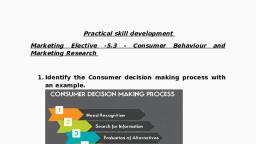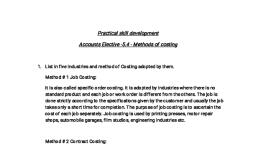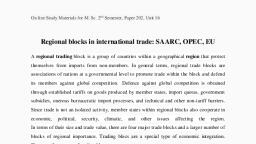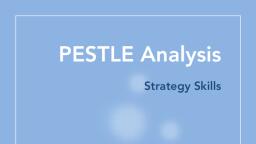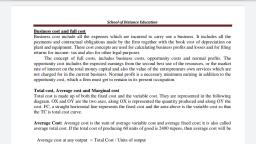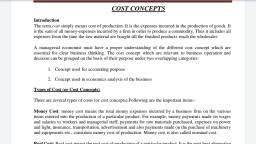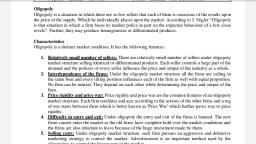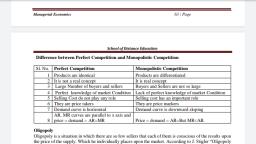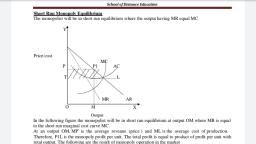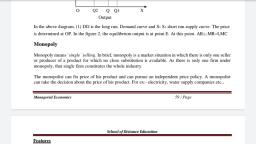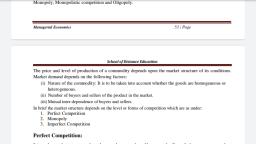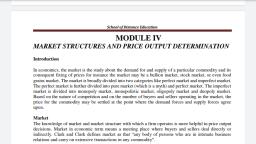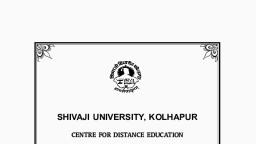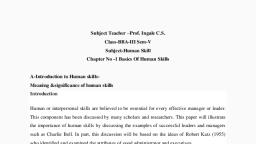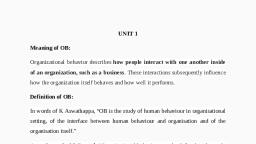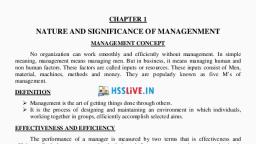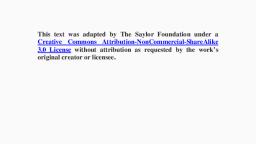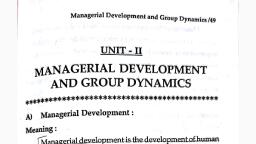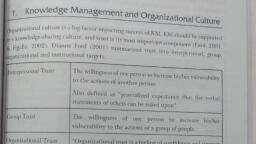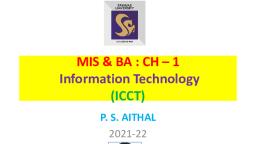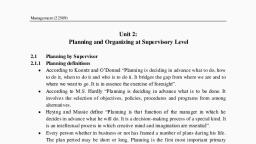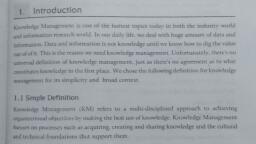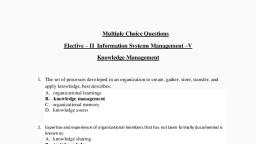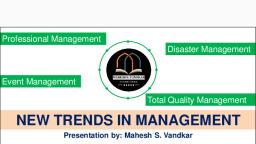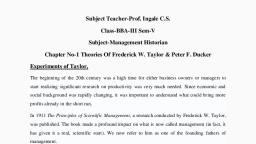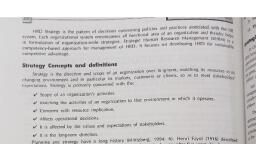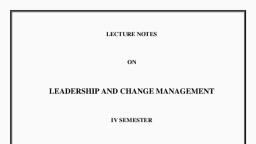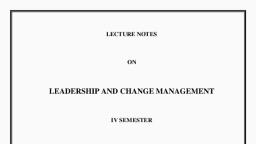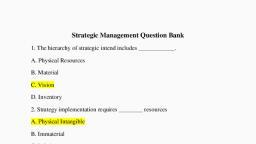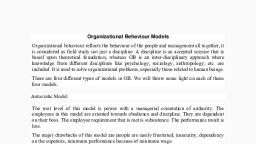Page 1 :
Knowledge Management - Introduction, Knowledge management is the systematic management of an organization's knowledge assets for creating value and meeting tactical & strategic requirements. It consists of the initiatives, processes, strategies, and systems that sustain and enhance the storage, assessment, sharing, refinement, and creation of knowledge.Each enterprise should define knowledge management in terms of its own business objectives. Knowledge management is all about applying knowledge in new, previously overburdened or novel situations., Meaning of knowledge management, Knowledge management (KM) is the collection of methods relating to creating, sharing, using and managing the knowledge and information of an organization. It refers to a multidisciplinary approach to achieve organisational objectives by making the best use of knowledge., The Goal of Knowledge Management/Objectives of knowledge management, Knowledge management is an essential and conscious process within an organization. It has to do with the definition, retention, sharing, structuring of knowledge, and employee experience within the organization., knowledge management, it is easy to improve work efficiency within the organization and retain knowledge., knowledge management helps to train your employees and how they learn within the organization., Knowledge is created, audited, shared in a manner that ensures growth and effectiveness in the organization., Knowledge management also ensures that employees within the organization are knowledge seekers., Types of Knowledge, Explicit Knowledge, This type of knowledge can be taught and codified easily. This involves simple things like mathematical equations or changing a printer's toner., ● Tacit Knowledge, This type of knowledge is not as easy to package or share as explicit knowledge, as it is more intuitive. Understanding body language and innovative thinking are good examples of tacit knowledge., Features Every Knowledge Management System, (1) accessibility,, (2) collaboration,, (3) customization, and, (4) recognition., Knowledge Acquisition and Application, Knowledge acquisition is the process used to describe the rules and ideologies required for a knowledge-based system. It is the process of extracting knowledge from experts and structuring this knowledge into a readable form., Some techniques used in the process of extracting information are Interviewing, Observations, Protocol Analysis, and Brainstorming., Introduction, Knowledge Management is a Continuous Cycle, Knowledge management is currently seen as a continuous cycle of three processes, namely −, Knowledge creation and improvement, Knowledge distribution and circulation, Knowledge addition and application, Knowledge management expresses a deliberate, systematic and synchronized approach to ensure the full utilization of the company’s knowledge base, paired with the potential of individual skills, competencies, thoughts, innovations, and ideas to create a more efficient and effective company., In simple words, knowledge management incorporates both holding and storing of the knowledge perspective, with respect to the intellectual assets., It is the deliberate and systematic collaboration of an organization’s people, technology, processes, style and structure in order to add value through reuse and innovation., Knowledge Management Theory, There are three distinct perspectives on Knowledge Management which leads to a different estimation and a different definition., Knowledge Management Theory, Knowledge management is a business activity with two primary aspects −, Executing the knowledge component of business activities as an explicit concern of business in strategy, policy, and practice at all levels of the organization., Maintaining a direct link between an organization’s intellectual assets both explicit (recorded) and tacit (personal know-how) and positive business results., What Cognitive Science or Knowledge Science Perspective Says?, Knowledge management is the transformation of knowledge in the form of insights, understandings, and practical know-how that we all possess in other manifestations like books, technology, practices, and traditions within organizations of all kinds and in society in general., According to the Process/Technology Perspective, Knowledge management is the concept under which information is changed into actionable knowledge and made available effortlessly in a usable form to the people who can leverage it according to their needs., Why Knowledge Management, Application of Knowledge Management (KM) lie in the below four key areas, Globalization of Business − Organizations today are more universal i.e., they are operating in multiple sites, multilingual, and multicultural in nature., Leaner Organizations − Organizations are adopting to a lean strategy where they understand customer value and focus on key processes to continuously increase it. The ultimate goal is to provide perfect value to the customer through a perfect value creation process that has zero waste., Corporate Amnesia − We are freer as a workforce, which creates issues regarding knowledge continuity for the organization and places with continuous learning demands from knowledge worker. We no longer expect to spend our entire work life with the same organization., Technological Advances − The world is more connected with the advent of websites, smart phones and other latest gadgets. Advancements in technology has not only helped in better connectivity but also changed expectations. Companies are expected to have online presence round the clock providing required information as per the customer needs., Knowledge Management serves as one of the major response to the challenge of trying to handle this complex, information overloaded work environment. As such, Knowledge management is perhaps best clustered as a science of complexity., Knowledge management cycle is a process of transforming information into knowledge within an organization. It explains how knowledge is captured, processed, and distributed in an organization., Till date, four models have been selected based on their ability to meet the growing demands. The four models are the Zack, from Meyer and Zack (1996), the Bukowitz and Williams (2000), the McElroy (2003), and the Wiig (1993) KM cycles., Zack Knowledge Management Model, The Zack model is extracted from work on the design and development of information products. In Meyer and Zack’s approach, the network between each stage is designed to be logical and standardized., In this cycle, the major developmental stages of a knowledge repository are analyzed and mapped to the stages of a KM cycle., The stages are acquisition, refinement, storage/retrieval, distribution, and presentation/use. This cycle is also known as the “refinery.”, Acquisition of Data or Information, Acquisition deals with issues regarding origin of raw materials such as scope, breadth, depth, credibility, accuracy, timeliness, relevance, cost, control, and exclusivity., The guiding principle is the well- known proverb of “garbage in, garbage out.” That is, highest quality source data is required, else the intellectual products produced downstream will be lower., Refinement, Refinement may be physical (like migrating from one medium to another) or logical (like restructuring, relabeling, indexing, and integrating.), Refining also defines cleaning up (like sanitizing content so as to ensure complete anonymity of sources and key players involved) or standardizing (like conforming to templates of a best practice or lessons learned as used within that particular organization)., This stage also adds up to the value by creating more readily usable knowledge objects and by storing the content more flexibly for future use., Storage / Retrieval, Storage or Retrieval forms a bridge between the upstream addition and refinement stages that feed the repository and downstream stages of product generation. Storage can be physical (file folders, printed information) as well as digital (database, knowledge management software)., Distribution, Distribution defines how the product is to be delivered to the end-user (like fax, print, email) and encloses not only the medium of delivery but also its timing, frequency, form, language, and so on., Presentation, Context plays an important role in Presentation or Application stage. The performance of each of the preceding value-added steps is evaluated here – for example, does the user have enough context to be able to make use of this content? If not, the KM cycle has failed to deliver value to the individual and ultimately to the company., The repository and the “refinery” combined enable the management of valuable knowledge of a firm. In this cycle, there is also an impression of having to continually renew the repository and the refinery in order to avoid elimination., The Meyer and Zack model is one of the most complete picture of the key elements engaged in the knowledge management model. To be specific the notion of refinement is a crucial stage in the KM cycle and one that is often neglected., Bukowitz & Williams Model, Bukowitz and Williams portray a knowledge management process framework that outlines “how organizations generate, maintain and expand a strategically correct stock of knowledge to create value”., In this framework, knowledge includes knowledge repositories, relationships, information technologies, communications infrastructure, functional skill sets, process know-how, environmental responsiveness, organizational intelligence, and external sources., These stages aim on more long-range processes of matching intellectual capital to strategic needs., Get Stage is the first stage, it consists of seeking out information required in order to make decisions, solve problems, or innovate., Use Stage is the next stage, and it deals with how to combine information in new and interesting ways in order to foster organizational innovation. The spotlight is primarily on individuals and then on groups., The Learn Stage points to the formal process of learning from experiences as a means of creating competitive gain. Learning in enterprises is important because it serves the transition step between the application of ideas and the generation of new ones., The Contribute Stage of the Knowledge Management cycle deals with encouraging employees to post what they have learnt to the communal knowledge base (like a repository). Only in this way, can individual knowledge be made visible and available to the entire organization, where and when appropriate., McElroy Model, McElroy outlines a knowledge life cycle that consists of the processes of knowledge production and knowledge integration, with a series of feedback loops to organizational memory, beliefs, and claims and the business-processing environment., Problem claim formulation is an attempt to learn and state the specific nature of the detected knowledge gap., Knowledge claim formulation acts as a response to approved problem claims via information acquisition and individual and group learning., New knowledge claims are tested and examined through knowledge claim evaluation processes., Evaluation of knowledge claims results in surviving knowledge claims that will be integrated as new organizational knowledge or falsified/undecided knowledge claims., Experience gained from the application of knowledge in the organizational knowledge base leads to new claims and resulting beliefs, triggering the cycle to begin all over again., In knowledge production, the primary processes are individual and group learning. Knowledge claim formulation, information acquisition; codified knowledge claim and knowledge claim evaluation., These knowledge production processes can be briefed as −, Individual and group learning marks the first step in organizational learning., Knowledge claim validation includes codification at an organizational level., A formalized procedure is essential for the receipt and codification of individual and group innovations., Information addition is the process by which an organization deliberately or serendipitously acquires knowledge claims or information produced by others, usually external to the company. This stage plays a basic role in formulating new knowledge claims at the organizational level., Knowledge integration is the process by which an organization announces new knowledge claims to its operating environment and retires old ones. It includes all knowledge transmission such as teaching, knowledge sharing, and other social activities that either connects an understanding of previously produced organizational knowledge to knowledge workers or accommodate newly minted knowledge., One of the advantages of the McElroy cycle is the clear description of how knowledge is examined and a conscious decision is made as to whether or not it will be included into the organizational memory. The authorization of knowledge is a step that clearly differentiates knowledge management from document management. The KM cycle aims at processes to identify knowledge content that is of value to the organization and its employees, WIIG Model, WIIG highlights the three conditions that need to be present for an organization to conduct its business successfully., It must have a business (commodities/services) and customers., It must have resources (people, budget, and facilities)., It must have the strength to act., WIIG marks the major purpose of KM as an effort “to make the organization intelligent-acting by facilitating the creation, accumulation, deployment and use of quality knowledge.” WIIG’s KM cycle shows how knowledge is built and used as individuals or as organizations., The following figure shows the four major steps of the WIIG model., Building knowledge − From external and internal knowledge sources, Holding knowledge − Storing the information in a particular form, Pooling knowledge − Through intranets and knowledge management portals, Applying knowledge − In the context of work embedded in process, Integrated Cycle, The following are the three major stages of integrated cycles of knowledge management strategy when introduced in any organization −, Knowledge capture and/or creation, Knowledge sharing and dissemination, Knowledge acquisition and application, Knowledge Capture states the identification and frequent codification of existing (usually previously unnoticed) internal knowledge and know-how within the organization and/or external knowledge from the environment., Knowledge Creation is the advancement of new knowledge and know-how innovations that did not have a previous existence within the organization., Once, it is clear that the newly identified content is of sufficient value, the next step is to contextualize this content. This involves maintaining a connection between the knowledge and those knowledgeable about that content., Contextualization also indicates identifying the key elements of the content in order to better match to a variety of users. Finally, contextualization succeeds to when the new content is firmly, precisely yet seamlessly, embedded in the business processes of the enterprise., The knowledge management cycle is then rechecked as users understand and decide to make use of content., The users will update usefulness, and they will signal when it becomes out of date or when this knowledge is not applicable., von Krogh and Roos Model, The von Krogh and Roos model of organizational epistemology (1995) is the first model that precisely differentiates between individual knowledge and social knowledge., This model, analyzes the following aspects, Why and how the knowledge gets to the workers of a company, Why and how the knowledge arrives at the organization, What does knowledge mean for the workers as well as the organization, What are the barriers of organizational knowledge management, In their organizational model, knowledge is to be found both in the mind of the people and in the links between them., This model examines the nature of knowledge management from the perspective of −, Staff members, Communication and connection, Organizational structure and layout, Network between members and, Management of human resources, The above five factors create issues that can prevent knowledge management strategies., Nonaka and Takeuchi, The Nonaka and Takeuchi model of KM has its base in a universal model of knowledge creation and the management of coincidence., There are four different modes of knowledge conversion in the Nonaka and Takeuchi model of knowledge conversion −, Socialization (tacit to tacit) i.e. Indirect way,, Externalization (tacit to explicit) i.e. Indirect to Direct way,, Combination (explicit to explicit) i.e. Direct way, and, Internalization (explicit to tacit) i.e. Direct to indirect way., Socialization is the technique of sharing tacit knowledge through observation, imitation, practice, and participation in formal and informal communities and groups. This process is basically preempted by the creation of a physical or virtual space where a given community can interact on a social level., Externalization is the technique of expressing tacit knowledge into explicit concepts. As tacit knowledge is highly internalized, this process is the key to knowledge sharing and creation., Combination is the technique of integrating concepts into a knowledge system. Some examples or cases would be a synthesis in the form of a review report, a trend analysis, a brief executive summary, or a new database to organize content., Internalization is the technique of embodying explicit knowledge into tacit knowledge., WIIG Model, Karl Wiig KM model (1993) marks the basic principle which says, in order for knowledge to be useful and valuable, it must be organized and synchronized., Some essential dimensions in the WIIGS KM model are −, Completeness, Connectedness, Congruency and, Perspective and purpose, 1.Completeness − It describes how much relevant knowledge is available from a given source. Sources vary from human minds to knowledge bases (like, tactic or explicit knowledge)., First of all, we have to make sure, that the knowledge is complete if all the information available on the subject is there but if no one knows of its existence, they cannot make use of this knowledge., 2.Connectedness − It briefs about the well-understood and well-defined relations between the different knowledge objects. Most knowledge objects are connected to each other, the more connected a knowledge base is then the more consistent the content and the greater its value., 3.Congruency − A knowledge base congruent when all the facts, concepts, perspectives, values, judgments, and relational links and connections between the objects are consistent. Most knowledge content do not meet such ideals., 4.Perspective and Purpose − It is a technique through which we know something but from a particular point of view for a specific purpose. We organize much of our knowledge applying to the dual dimensions of perspective and purpose., This model attempts to define different levels of internationalization of knowledge and therefore could be seen as a further refinement of the fourth Nonaka and Takeuchi quadrant of internalization.

